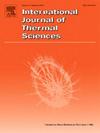Performance evaluation of 3D multi-layer flat-plate oscillating heat pipe under hypergravity conditions with artificially gravity-assisted and anti-gravity operation
IF 4.9
2区 工程技术
Q1 ENGINEERING, MECHANICAL
International Journal of Thermal Sciences
Pub Date : 2025-06-07
DOI:10.1016/j.ijthermalsci.2025.110073
引用次数: 0
Abstract
Efficient thermal management in complicated or extreme environments becomes a severe challenge for safety and reliable applications of electronic devices. In this paper, the thermal performance of a novel three-dimensional (3D) multi-layer flat-plate oscillating heat pipe (FPOHP) under rotation-induced hypergravity conditions was experimentally investigated. The nominal gravity level (gnom) changed in the range of 1.0 (Earth's gravity) to 10.0, and R134a was used as the working fluid at a volumetric filling ratio of 40 %. The 3D FPOHP could startup and operate smoothly at the anti-gravity condition (against gravity) under gnom = 10.0, even though better thermal performance was obtained at the gravity-assisted condition. For the gravity-assisted rotation configuration, the increase of gnom can reduce average evaporator temperatures and enhance heat transfer performance, and the FPOHP obtained an effective thermal conductivity (ETC) of 2034.9 W/(m·K) at the power input of 300 W under gnom = 10.0, increased by 49.8 % than that of gnom = 1.0. For the anti-gravity rotational configuration, however, the average evaporator temperature almost remained unchanged with the increase of gnom at medium and high power inputs, and the ETC is about 5.6 times higher than the pure aluminum at the power input of 300 W under gnom = 10.0. Additionally, the average evaporator temperatures were about 65.0 °C and 51.6 °C for anti-gravity and gravity-assisted situations, respectively. The Coriolis-effect induced lateral displacement of bubbles/plugs acts a positive role to enhance the FPOHP performance. Even though the channel diameter of the FPOHP is much greater than the predicted maximum allowable value at a large gnom, it can still work well, indicating the limitation of the critical diameter criterion. This study deepens the understanding of OHP operation in hypergravity environments and provides insights for their applications in aerospace and high-speed rotating systems.
三维多层平板振荡热管在人工重力辅助和反重力工况下的超重力性能评价
在复杂或极端环境下的高效热管理成为电子设备安全可靠应用的严峻挑战。本文对一种新型三维多层平板振荡热管(FPOHP)在旋转诱导的超重力条件下的热性能进行了实验研究。标称重力等级(gnm)在1.0(地球重力)~ 10.0范围内变化,工作流体采用R134a,体积充填比为40%。在gnm = 10.0条件下,3D FPOHP在反重力(反重力)条件下能够顺利启动和运行,而在重力辅助条件下获得了更好的热性能。在重力辅助旋转构型下,增大gnm可降低蒸发器平均温度,提高传热性能,在gnm = 10.0时,FPOHP在功率为300 W时的有效导热系数(ETC)为2034.9 W/(m·K),比gnm = 1.0时提高了49.8%。而对于反重力旋转配置,在中、高功率输入下,随着gnm的增大,蒸发器的平均温度基本保持不变,在gnm = 10.0时,在300 W的功率输入下,ETC比纯铝高约5.6倍。此外,在反重力和重力辅助情况下,蒸发器的平均温度分别约为65.0°C和51.6°C。科里奥利效应引起的气泡/塞的侧向位移对提高FPOHP性能起着积极的作用。即使FPOHP的通道直径远远大于预测的最大允许值,但它仍然可以很好地工作,这表明临界直径准则的局限性。该研究加深了对超重力环境下OHP运行的理解,并为其在航空航天和高速旋转系统中的应用提供了见解。
本文章由计算机程序翻译,如有差异,请以英文原文为准。
求助全文
约1分钟内获得全文
求助全文
来源期刊

International Journal of Thermal Sciences
工程技术-工程:机械
CiteScore
8.10
自引率
11.10%
发文量
531
审稿时长
55 days
期刊介绍:
The International Journal of Thermal Sciences is a journal devoted to the publication of fundamental studies on the physics of transfer processes in general, with an emphasis on thermal aspects and also applied research on various processes, energy systems and the environment. Articles are published in English and French, and are subject to peer review.
The fundamental subjects considered within the scope of the journal are:
* Heat and relevant mass transfer at all scales (nano, micro and macro) and in all types of material (heterogeneous, composites, biological,...) and fluid flow
* Forced, natural or mixed convection in reactive or non-reactive media
* Single or multi–phase fluid flow with or without phase change
* Near–and far–field radiative heat transfer
* Combined modes of heat transfer in complex systems (for example, plasmas, biological, geological,...)
* Multiscale modelling
The applied research topics include:
* Heat exchangers, heat pipes, cooling processes
* Transport phenomena taking place in industrial processes (chemical, food and agricultural, metallurgical, space and aeronautical, automobile industries)
* Nano–and micro–technology for energy, space, biosystems and devices
* Heat transport analysis in advanced systems
* Impact of energy–related processes on environment, and emerging energy systems
The study of thermophysical properties of materials and fluids, thermal measurement techniques, inverse methods, and the developments of experimental methods are within the scope of the International Journal of Thermal Sciences which also covers the modelling, and numerical methods applied to thermal transfer.
 求助内容:
求助内容: 应助结果提醒方式:
应助结果提醒方式:


